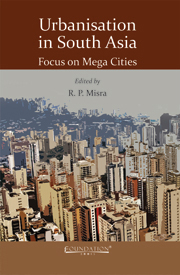Book contents
- Frontmatter
- Contents
- List of Figures
- List of Tables
- List of Contributors
- Introdution
- 1 South Asia: Land, People, and Economy
- 2 Historical Roots of South Asian Urbanisation
- 3 Mumbai: The Financial Capital of India
- 4 Delhi: Growing Problems of a Growing Megalopolis
- 5 Calcutta: The Emergence of Colonial Settlement into Megacity of the East
- 6 Chennai: A Rural Metropolis in Search of Modernity
- 7 Hyderabad: From the Feudal City to a Hi-Tech Metropolis
- 8 Bangalore: From Garden City to Silicon Valley of India
- 9 Karachi: The Commercial Capital of Pakistan
- 10 Lahore: The Cultural Heart of Pakistan
- 11 Kabul: A City in Perpetual Turmoil
- 12 Dhaka: A Mega City of Persistence and Change
- 13 Kathmandu: A City Where Tradition and Modernity Overwhelm Each Other
- 14 Thimphu: The City of Peace and Organic Development
- 15 Colombo: The Primate City of Sri Lanka
- 16 Male: Island Capital of an Island Nation
- 17 Beyond the Present: Vision of a New Urban Future
- Index
3 - Mumbai: The Financial Capital of India
Published online by Cambridge University Press: 05 September 2013
- Frontmatter
- Contents
- List of Figures
- List of Tables
- List of Contributors
- Introdution
- 1 South Asia: Land, People, and Economy
- 2 Historical Roots of South Asian Urbanisation
- 3 Mumbai: The Financial Capital of India
- 4 Delhi: Growing Problems of a Growing Megalopolis
- 5 Calcutta: The Emergence of Colonial Settlement into Megacity of the East
- 6 Chennai: A Rural Metropolis in Search of Modernity
- 7 Hyderabad: From the Feudal City to a Hi-Tech Metropolis
- 8 Bangalore: From Garden City to Silicon Valley of India
- 9 Karachi: The Commercial Capital of Pakistan
- 10 Lahore: The Cultural Heart of Pakistan
- 11 Kabul: A City in Perpetual Turmoil
- 12 Dhaka: A Mega City of Persistence and Change
- 13 Kathmandu: A City Where Tradition and Modernity Overwhelm Each Other
- 14 Thimphu: The City of Peace and Organic Development
- 15 Colombo: The Primate City of Sri Lanka
- 16 Male: Island Capital of an Island Nation
- 17 Beyond the Present: Vision of a New Urban Future
- Index
Summary
Mumbai, earlier known as Bombay, has been described as the most ‘city-like city’ in India; some call it the urbs prima of India while others address it as the New York of the East. It was the ‘Gateway’ to India in colonial days and it remains so even today. In terms of population size within the municipal limits, Mumbai ranks second in the world. As an urban agglomeration, it ranks sixth among the large cities of the world. The ‘Vision Mumbai’ document prepared by McKinsey & Co. provides a blueprint for its transformation into a world city within the 2003-13 decade.
Mumbai, apart from being the capital of the state of Maharashtra, is the Indian financial capital and a dominant urban landscape of the western part of the ountry. Its nodal location in terms of land, sea and air connectivity, both national and international, adds to its magnetism as a leading industrial and commercial centre. It is the nerve centre of capital markets, financial services, and manufacturing, playing a crucial role in the growth and development of the Indian economy. It has attracted a large number of national and multinational firms since a long time. The exploitation of the offshore oilfields such as Bombay High and the city's key role in naval defence has enhanced its supremacy as a mega city of India.
- Type
- Chapter
- Information
- Urbanisation in South AsiaFocus on Mega Cities, pp. 78 - 108Publisher: Foundation BooksPrint publication year: 2012
- 4
- Cited by



